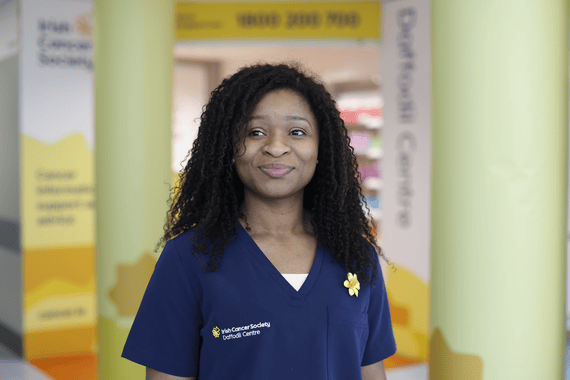Non-Hodgkin lymphoma
Diagnosis and tests
Diagnosing non-Hodgkin lymphoma
Your family doctor (GP) will talk to you about your symptoms and arrange blood tests if needed. If your blood test is abnormal you will be referred to hospital to have a test called a lymph node biopsy.
This test involves removing a sample of cells from an enlarged lymph node and looking at them closely under a microscope in the laboratory. If the enlarged node is on your neck, the cells can be taken without putting you to sleep. If the node is deeper, like in your chest, you will need a general anaesthetic, which means you will be asleep for the procedure.
Read more about having a lymph node biopsy.

If you are diagnosed with non-Hodgkin lymphoma, we're here for you.
Our cancer nurses are here if you need information or just want to talk. They can help you to understand your diagnosis and what to expect, send you information and tell you about our services.
Further tests for non-Hodgkin lymphoma
You may need further tests to give your doctors more information about your general health and about the cancer. For example:
- The number and location of affected lymph nodes.
- If the affected lymph nodes are above or below your diaphragm. Your diaphragm is the thin muscle under your lungs and heart that separates your chest from your abdomen.
- If the disease is found in your bone marrow or in places outside the lymphatic system, such as your liver.
A special type of X-ray that gives a detailed picture of the inside of your body.
Read more about CT scans.
This uses sound waves to build up a picture of the tissues inside the body. It may be used to look at the organs inside the abdomen such as the liver or spleen. It may also be used to look at lymph nodes in your neck, armpit or groin.
Read more about ultrasound scans.
A low dose of radiotracer (radioactive sugar) is injected into your arm. An hour or so later, you will have the scan. The PET scan uses the radiotracer to highlight cancer cells in your body. This can give your doctor more information about where the cancer is or if it has spread to other tissues and organs.
Read more about PET scans.
Taking a sample of your bone marrow (and maybe bone) and looking at it under a microscope to see the number and type of cells in it.
Read more about having a bone marrow biopsy.
You might have a lumbar puncture done before you start treatment. This looks at a sample of the fluid around your brain and within your spinal cord (cerebrospinal fluid or CSF) to see if there are any lymphoma cells in it. Repeated lumbar punctures and injections of chemotherapy may be needed as part of your treatment. The chemotherapy is injected in the spinal fluid after the CSF sample has been removed.
Read more about having a lumbar puncture.
A scan that uses magnetic energy to build up a picture of the tissues inside your body.
Read more about MRI scans.
The tests you have can help to stage your cancer. This means finding out the size and position of the cancer.
Some tests may be used see how you are responding to treatment.
A haematologist is a doctor who specialises in treating blood and bone marrow problems.
Waiting for test results
While some results may come back quickly, others may take a few weeks.
Waiting for results can be an anxious time. It may help to talk things over with your doctor or nurse or with a relative or close friend.
You can also call our Support Line on 1800 200 700 or visit a Daffodil Centre to speak to a cancer nurse.
What are the stages of non-Hodgkin lymphoma?
Staging means finding out how much of your body is affected by the disease. Staging will help your doctor to plan the best treatment for you.
Non-Hodgkin lymphoma is usually described using numbers 1-4 and letters A, B and E, depending on your symptoms and how many lymph nodes or organs are involved.
Number staging
Your doctor often uses this information to give your cancer a number stage – from 1 to 4. In general, the lower the number, the less advanced the cancer. A higher number means a more advanced cancer.
One group of lymph nodes is affected on one side of your diaphragm or in a single organ.
2 or more groups of lymph nodes are affected either above or below your diaphragm.
Lymph nodes are affected both above and below your diaphragm.
Lymphoma can be found in organs outside your lymphatic system or in your bone marrow.
Knowing the stage of your cancer helps your team to plan the best treatment for you.
Early and late-stage lymphoma
Early stage: This includes stage 1 and possibly stage 2.
Late stage: This is usually stage 2, 3 or 4. It is possible to treat and cure advanced-stage lymphoma.
Letter codes
- A: You have no symptoms other than swollen glands
- B: You have other symptoms, such as weight loss, fever and night sweats
- E: The lymphoma is in unusual places outside your lymph nodes. For example, in your stomach. This is called extranodal lymphoma (the letter E stands for extranodal).
Staging can be hard to understand, so ask your doctor and nurse for more information if you need it.
Continue reading about non-Hodgkin lymphoma




Get help & support

Support Line
Free support pack

